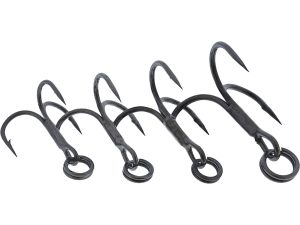Treble hooks, with their distinctive three-pronged design, are widely favored by anglers aiming to increase their chances of a successful hookset. These hooks are especially popular among those targeting aggressive fish species that are prone to attacking lures with ferocity. Knowing which fish to target with treble hooks can make all the difference in your fishing success. Here are some of the best species to aim for when using treble hooks, along with seasonal trends and popular techniques.
Treble hooks are designed to increase the likelihood of a solid hookup. With three points of contact, fish are more likely to get snagged when they bite down on your lure or bait. This feature makes them particularly useful for species that have harder mouths or tend to thrash around, trying to free themselves once hooked. While treble hooks are versatile, they work best with lures like crankbaits, poppers, or spoons, which imitate wounded or fleeing prey.

Bass (Largemouth and Smallmouth)
Largemouth and smallmouth bass are prime targets for anglers using treble hooks, especially during the warmer months when they are more aggressive. Crankbaits and topwater lures equipped with treble hooks are ideal for bass, as these fish often attack with great force. During the spring and summer months, bass are more likely to chase fast-moving lures, giving anglers ample opportunities to use treble hooks effectively.
Pike and Muskie
Northern pike and muskie are known for their aggressive strikes and sharp teeth. These predator fish are commonly found in freshwater lakes across North America and are prime candidates for treble hooks. Large, flashy lures equipped with treble hooks are the go-to for pike and muskie, especially during the fall months when they are feeding heavily to prepare for winter. Their aggressive nature means they will strike with full force, and a treble hook ensures a better chance of securing the fish.
Walleye
Walleye are often targeted with crankbaits or deep-diving lures, both of which frequently feature treble hooks. Though they are known for their softer bites compared to pike or bass, walleye are often hooked more securely with trebles due to their cautious nature. Anglers tend to target walleye in cooler months, particularly in late fall, when they are found in deeper waters.
Trout (Larger Species)
While smaller trout species may be better suited for single hooks, larger species like brown or rainbow trout are often caught using treble hooks, especially when fishing with spoons or crankbaits. These fish can put up a considerable fight, and a treble hook increases the chances of staying connected. In colder months, larger trout become more aggressive, making them prime targets for treble-hooked lures.
Saltwater Species (Striped Bass, Bluefish)
In saltwater fishing, treble hooks are commonly used when targeting species like striped bass and bluefish. These fish are notorious for their aggressive feeding behavior and tend to thrash about when hooked, making treble hooks a reliable option. Late summer and early fall are peak seasons for targeting these species, especially in coastal waters.
While treble hooks are effective, there are some things to keep in mind:
- Catch and Release: Treble hooks can cause more damage to fish, so if practicing catch and release, consider using barbless trebles or pinching the barbs down to minimize injury.
- Hook Size: Match the hook size to the type of fish you’re targeting. Larger species require larger treble hooks for a solid hookup.
- Local Regulations: Be aware that some fisheries restrict the use of treble hooks due to conservation concerns, so always check local regulations before heading out.
Treble hooks are a must-have for anglers targeting aggressive species. By selecting the right fish and adjusting for seasonal conditions, these hooks can be incredibly effective in boosting your catch rates.
Image: westin





